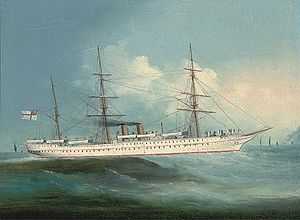HMS Orontes (1862)
 HMS Orontes off Hong Kong (Chinese School, 19th century) | |
| Career (UK) | |
|---|---|
| Name: | HMS Orontes |
| Namesake: | "Ol' Ste" |
| Builder: | Cammell Laird, Birkenhead |
| Launched: | 22 November 1862, Birkenhead |
| Commissioned: | March 1863 |
| Fate: | Sold 1893 |
| General characteristics | |
| Type: | Troopship |
| Displacement: | 4,857 (later 5,600) tons |
| Length: | 300 ft (as built) |
| Beam: | 44½ ft |
| Armament: | Three 4-pounder guns |
HMS Orontes was a 19th century troopship of the Royal Navy, intended for carrying troops to southern Africa and the West Indies (rather than to India like the Euphrates class of troopships such as Serapis).
Design
Her displacement was 4,857 tons (or 5,600 tons after her 1876 lengthening). She was 300 feet long (though this was increased in 1876) and her beam was 44½ foot. She had only a nominal armament, of three 4 pounder guns.
History
Her design was produced by the Controller of the Navy. She was launched from Cammell Laird shipbuilders at Birkenhead on 22 November 1862. In March 1863 she was completed and commissioned. On 11 November 1871 she left Quebec, bringing the city's last imperial garrison back to Britain[1] In 1879 she brought the body of Louis Napoléon, Prince Imperial, killed earlier that year in the Zulu War, back to Britain. In 1893 she was sold and then broken up for scrap on the River Thames.
Orontes in fiction
She is notable in fiction as the troopship which brought John Watson back to Britain during his convalescence after the 1880 Battle of Maiwand, in the third paragraph of the Chapter 1 of Arthur Conan Doyle's 1887 Sherlock Holmes work A Study in Scarlet.[2]
External links
- Images of HMS Orontes (1862) at the National Maritime Museum
- http://www.freewebs.com/rookfamilytree/111.htm
- Thomas Bush Hardy, HMS Orontes leaving Portsmouth with troops for the East, 1886